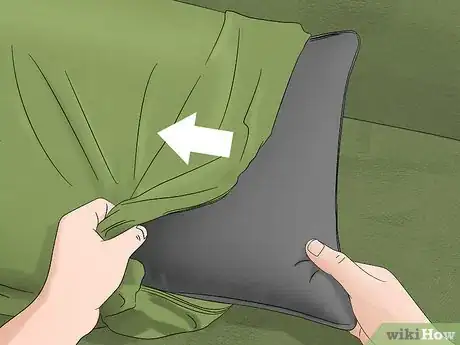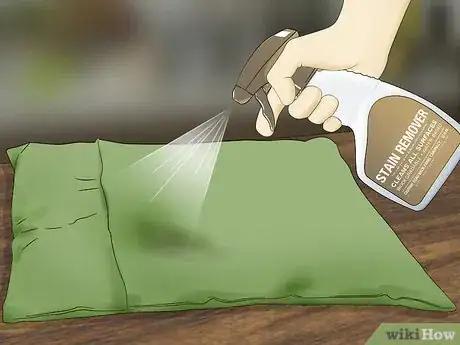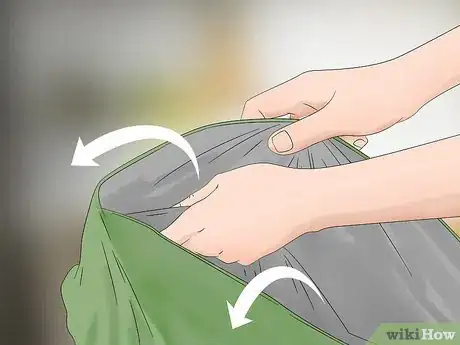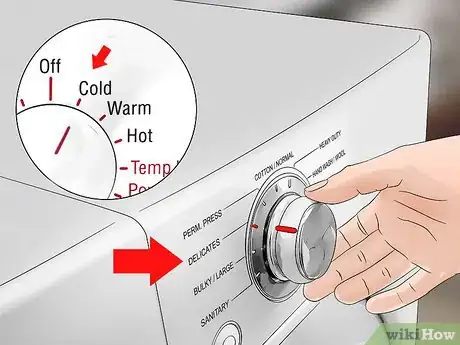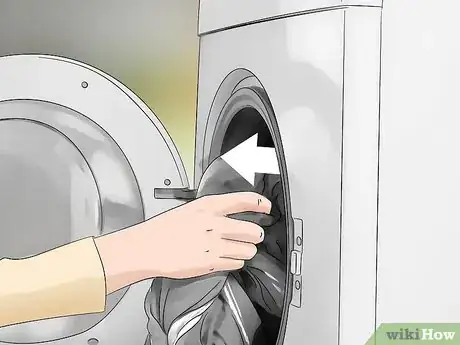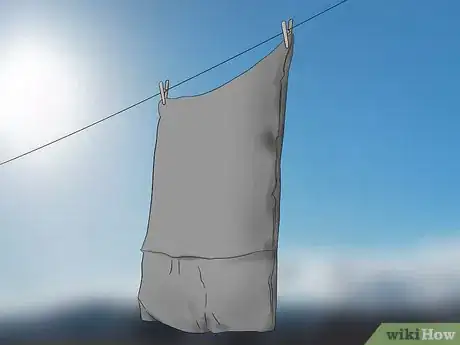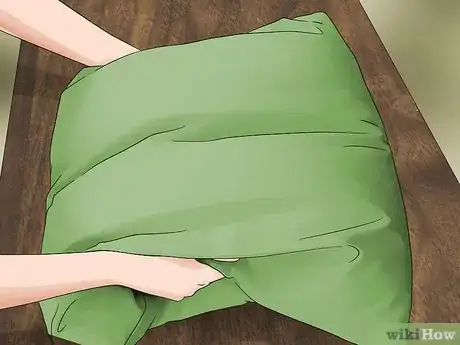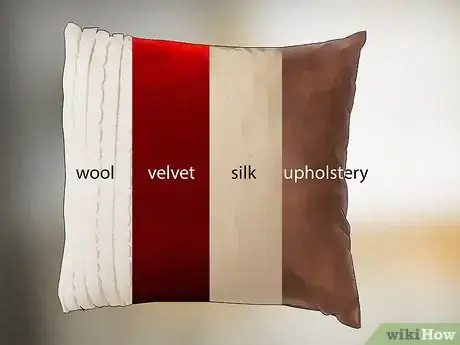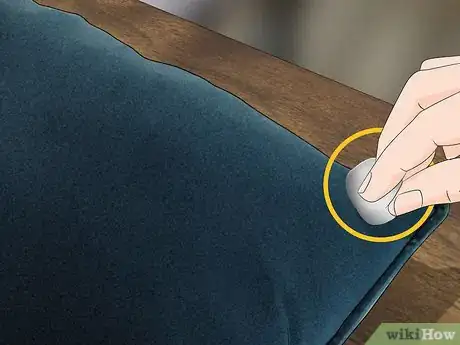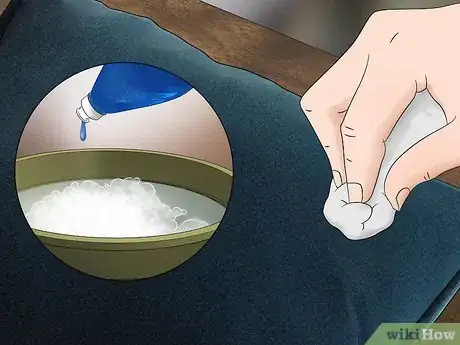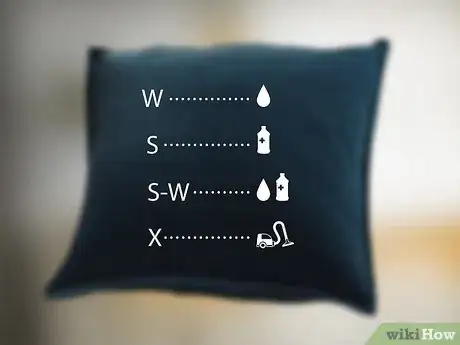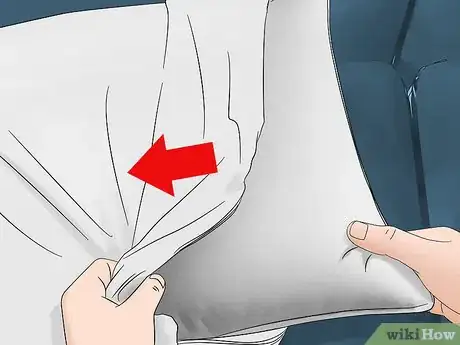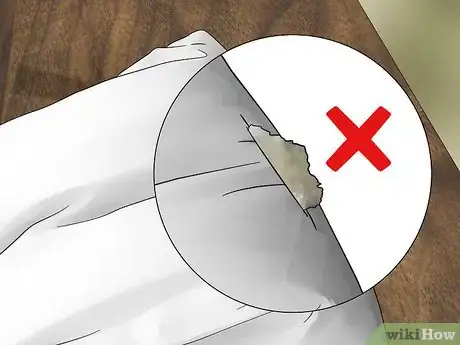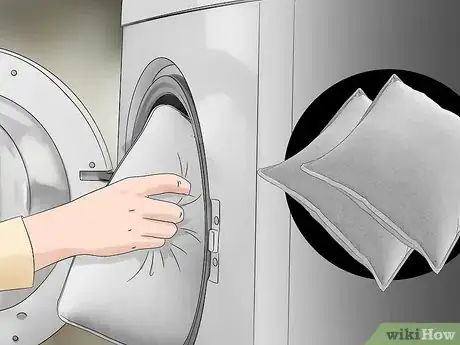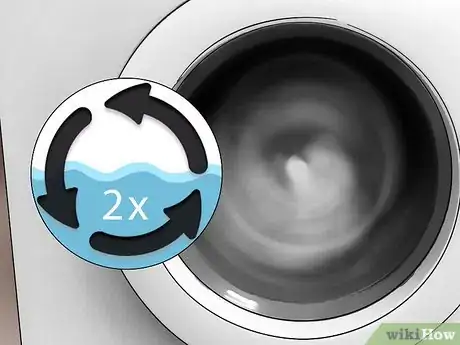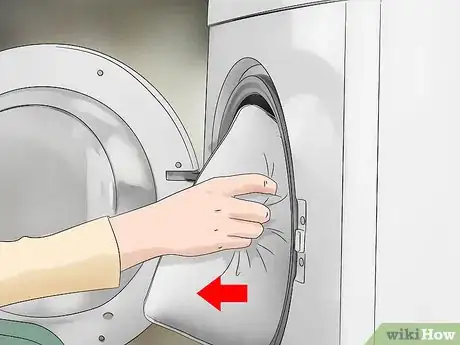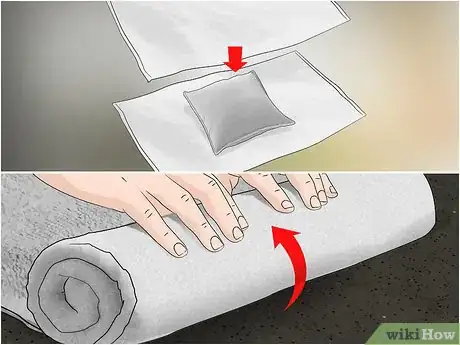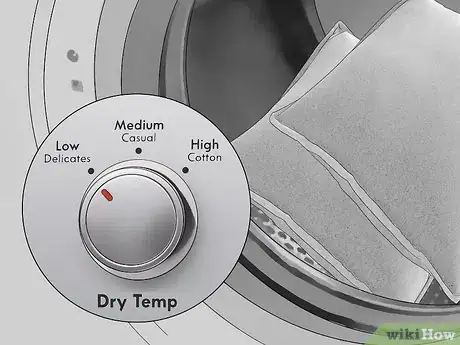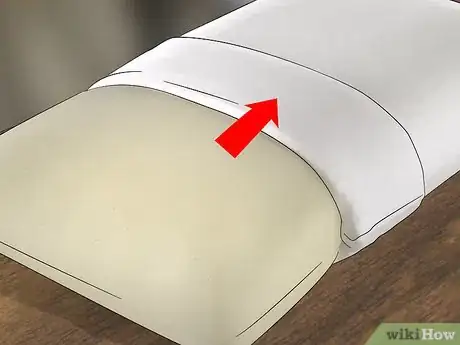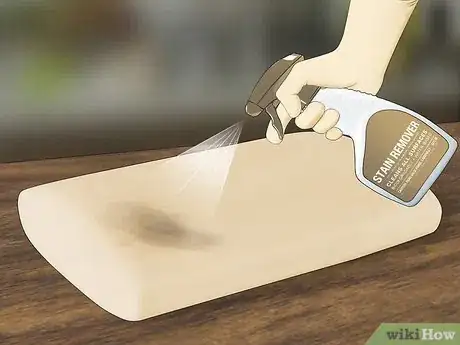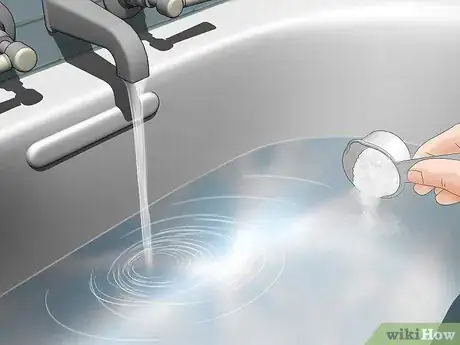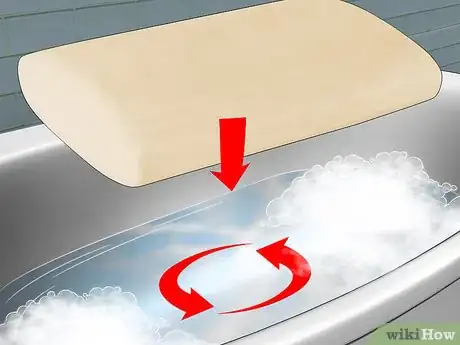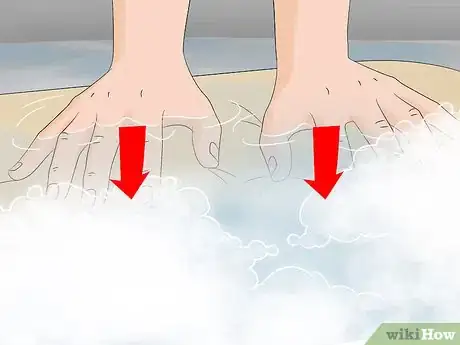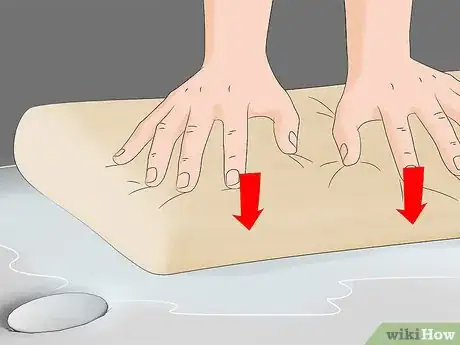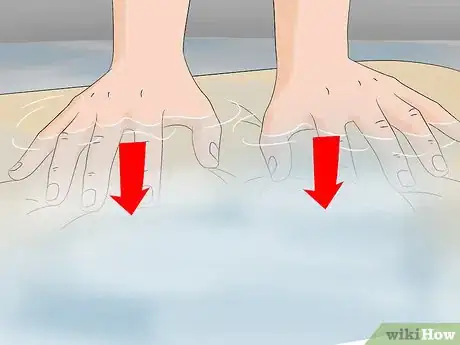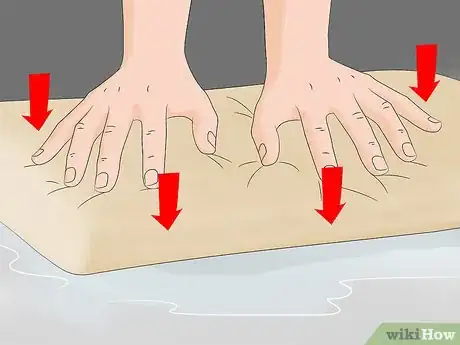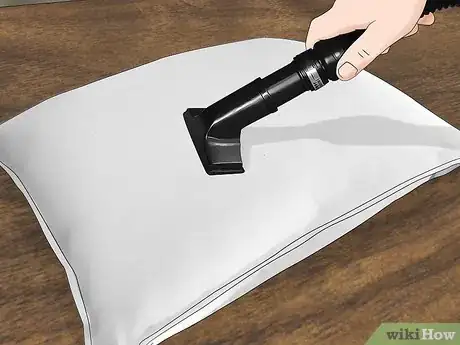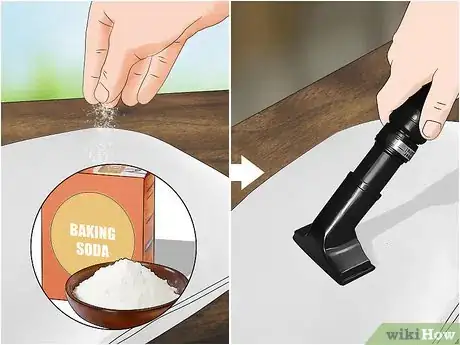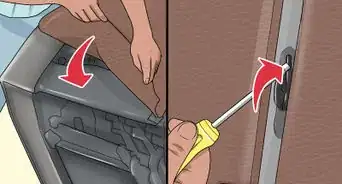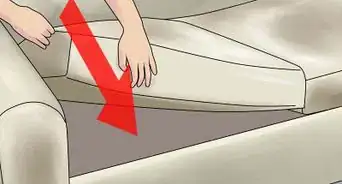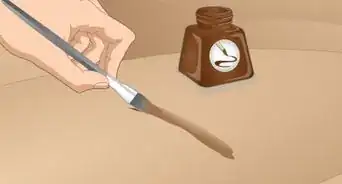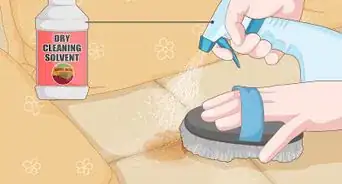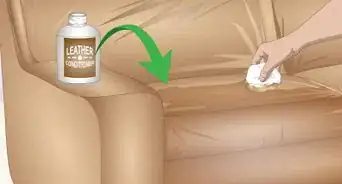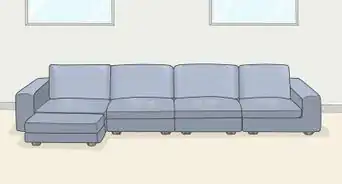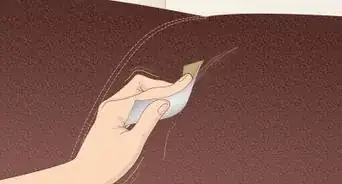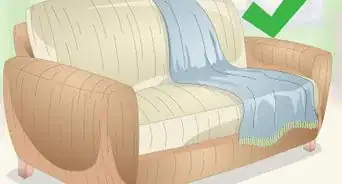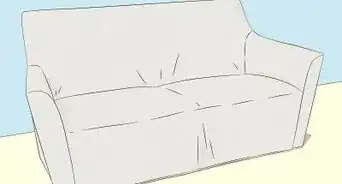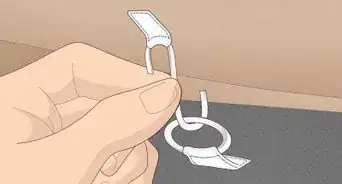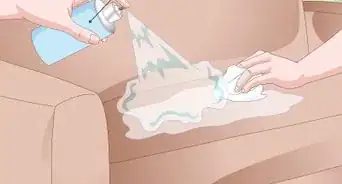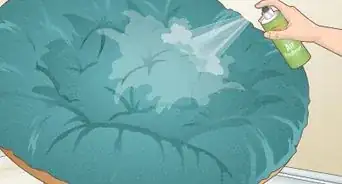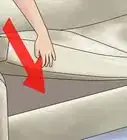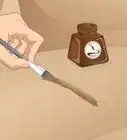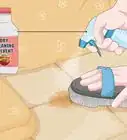This article was co-authored by Ashley Matuska. Ashley Matuska is a Professional Cleaner at the Founder and Owner of Dashing Maids in Denver, Colorado. Ashley has over seven years of experience in the cleaning industry. She and her team specialize in offering sustainable deep cleaning and maintenance cleaning services.
There are 13 references cited in this article, which can be found at the bottom of the page.
This article has been viewed 191,596 times.
Couch pillows, especially ones used everyday, attract dirt, bacteria, dust, mold and mites. Even decorative throw pillows are susceptible; so they need to be cleaned on a regular basis, too. Couch pillows covered in delicate material, such as silk, must be professionally dry-cleaned. Most other couch pillows can be washed in a machine or cleaned by hand, even ones that don’t have removable covers. Consult the manufacturer’s cleaning directions before attempting to clean any pillows.
Steps
Cleaning Removable Pillow Covers
-
1Remove the fabric cover. Note that this method is intended for pillow covers that are machine washable only. Most covers made out of cotton, linen, or polyester will be machine washable. Check the tag to make sure. If the cover is made out of wool, velvet, silk, or upholstery, it cannot be washed. You should take it to a dry-cleaner.
- Anything with intricate beading and trim should be dry-cleaned or spot-cleaned. A washing machine will be too rough on the details.
- Leather and suede pillow covers cannot be washed. They should be spot-cleaned only.
-
2Treat heavily stained areas with a stain removal spray. If you do not have one, you can make your own. Choose one of the following ingredient sets below, put everything into a plastic spray bottle, and shake. Spray the mixture onto the stain before continuing.Advertisement
-
3Turn the pillow cover inside out. This will help protect the original texture of the fabric. It will also help prevent the colors from fading in the wash.
-
4Wash the cover on a delicate cycle. Use cold water and a mild detergent. If the pillow itself is dirty too, you will need to wash it on a separate cycle. Click here to learn how to clean feather and fiberfill pillows, and here to learn how to clean foam pillows.
- If you don't have any mild detergent on hand, try using less of what you have, or baby shampoo.
-
5Remove the cover from the machine as soon as the cycle has ended. The longer something sits in the washer, the mustier it will smell.
-
6Dry the covers with care. The safest way to dry the covers would be to hang them on a clothesline. If you are in a hurry, however, you can toss them into the dryer on a low or no heat setting.
-
7Put the cover back on the pillow when it is completely dry. If you put the cover on the pillow too soon, the damp fabric will pick up more stains. It may also begin to smell musty, or cause the pillow itself to smell musty.
Cleaning Non-Removable Pillow Covers
-
1Determine what material the cover is made out of. Not all materials can be spot-cleaned. The following materials must be professionally dry-cleaned: wool, velvet, silk, and upholstery.
-
2Consider doing a spot test for color fastness on fabrics. If the stain is in an obvious area, consider doing a spot test in an inconspicuous area first. You can do this simply by soaking a cotton ball with water, and lightly dabbing it on the pillow. If the color bleeds, take the pillow to a dry-cleaner. If the color does not bleed, you can spot clean it.[4]
-
3Spot-clean stains on fabric and leather using soapy water. Pour some warm water into a bowl, and add a few drops of mild dish soap. Agitate the water until it becomes sudsy, then dip a cloth into the water. Use the dampened cloth to blot up any stains. Blot up any soap residue using a clean cloth dampened with fresh, non-soapy, water. Let the damp area air dry before you put the pillow cover back on.[5]
- If your pillow is made out of leather, consider using a leather conditioner afterwards. Make sure that you are using a leather conditioner intended for upholstery leather and not saddle leather.
-
4Do not use water on covers made from suede. Brush the entire piece using a soft-bristled brush to loosen dirt. Always go with the grain stead of against. A suede brush would be ideal, but a clean toothbrush or manicure brush might also work. If the stain remains, follow up with any of the following options:[6]
- Try white vinegar on stains. Dampen the brush with vinegar first, then go over the stain. Don't worry, the smell will go away.
- Use suede cleaner on tough stains. Consider doing a spot test first, in case of discoloration.
- Sprinkle cornstarch/cornflour over oily stains, wait overnight, then vacuum the next morning. Use a soft-bristled brush to comb out any residue cornflour/cornstarch.
- Use water with care. Some stains must be cleaned out with water. Dampen the brush first, then go over the stain--and the rest of the pillow. This will help conceal any potential discoloration.
-
5Clean microfiber with care. Read the care tag on your pillow and try to notice if there is a letter code on it. Choose one of the cleaning methods from the list below, based on the letter code. If the microfiber turns hard after you clean it, simply brush the fabric with a soft-bristled brush, such as a clean suede brush, toothbrush, or manicure brush.[7]
- If the tag has a W on it, you can use a water-based cleaner, such as soapy water.
- If the tag has a S on it, you can use an alcohol-based cleaner, such as rubbing alcohol or vodka.
- If the tag has a S-W on it, you can use either water or alcohol based-cleaners.
- If the tag has a X on it, you must vacuum the fabric.
- If there is no tag, use an alcohol-based cleaner.
Washing Feather and Fiberfill Pillows
-
1Remove the pillow insert from the cover from the pillow, if you can. If you cannot remove the pillow insert, make sure that the cover is washable. If it is not washable, you will need to spot clean the cover instead. Click here to learn how to clean a non-removable pillow cover.
-
2Make sure that there are no tears in the pillow, and repair any you find. The last thing you'd want is to put a damaged pillow into a washer, and open the door at the end of the cycle to find a pile of feathers. Before you stick your pillow into the washer, examine it carefully. Focus on the body of the pillow as well as the seams. If you see any rips or tears, stitch them up using a needle and thread.
-
3Place two pillows into the washer vertically, and do not include the rest of your laundry. Placing the pillows vertically will ensure that they won't wrap around the agitator while they are spinning and get tangled.[8]
- Washing two pillows at once will help balance out the drum inside the washing machine.
- Washing the pillows separate from the rest of your laundry will ensure that there is enough water to rinse the soap out properly.
- If the pillow is not washable, toss it into dryer with a few tennis balls or dryer balls. The head will kill any odor-causing bacteria.[9]
-
4Use cool to warm water, a mild soap, and a gentle cycle. When choosing soap, make sure that it is liquid and low sudsing; powdered detergent will be too difficult to wash out.
- If the care label on your pillow has different requirements for water temperature, detergent, and cycle setting, follow what the label says instead.[10]
-
5Consider doing another rinse cycle. Because pillows are so bulky, a single rinse cycle may not be enough. Many people find that they have to do an additional rinse cycle or two in order to get all of the suds out.[11]
-
6Remove the pillows promptly once the cycle ends. The longer they sit, the more likely they will end up smelling musty.
-
7Squeeze out any excess water by placing the pillow between two towels and rolling it up. Do not twist or wring the pillow. Instead, place it at the end of a large, clean towel. Place another towel right on top, so that the pillow is sandwiched in between. Start rolling the pillow along with the two towels, from one end to the other. Press down on the roll, then unravel it.
- Repeat this step for any other pillows you have just washed
-
8Dry the pillow in the dryer on a no-heat to low-heat setting. If the pillows are filled with feathers, use the no-heat setting. If the pillows are filled with a synthetic material, such as fiberfill, use a low-heat setting.[12]
- Consider adding a few dryer balls or tennis balls into the dryer along with the pillows. This will help them dry faster as well as fluff them up.[13]
- You can also lay pillows flat to dry. They will dry the fastest if they are laid out in the sun.
- If the care label on your pillow has different drying instructions, follow what the label says instead.[14]
-
9Place the covers onto the pillows once everything is completely dry. Do not cover wet pillows, or they will start to get moldy and smell musty.
Washing Foam Pillows
-
1Remove the pillow insert from the cover from the pillow, if you can. If you cannot remove the pillow insert, make sure that the cover is washable. If it is not washable, you will need to spot clean the cover instead. Click here to learn how to clean a non-removable pillow cover.
-
2Treat heavily stained areas with a stain removal spray. If you do not have one, pick one of the following ingredient sets below. Put everything into a plastic spray bottle, shake to mix, and then spray the mixture onto the stain before continuing.
-
3Fill a bathtub with warm water and add a mild detergent. Make sure that there is enough water to completely submerge the pillow. Also, try to use a detergent intended for hand washing; they tend to be gentler. When adding the detergent, follow instructions on the bottle in regards to amount.[18]
- If you cannot find a mild "hand washing" detergent, use a regular washing machine detergent. Decrease the amount you are using, and put on a pair of rubber gloves. You can also try using dish soap or baby shampoo.
-
4Agitate the water, then add the pillow. Depending on how large your pillows are, you may be able to fit more than one in your tub. If your pillows are very dirty to begin with, you might want to wash them one at a time.
-
5Press down on the pillow repeatedly. Not only will this force the pillow underwater, but the repeated pressing motion will force the water into it. The soapy water will help flush out any dirt and dust.[19]
- If your pillow is very dirty, you may need to replace the water. Just remember to add more detergent to any water changes.
-
6Drain the water and press out the excess water from the pillow. Drain the water first. Once the water is all gone, press down on the pillow to squeeze out any excess water. Don't worry if the water coming out of the pillow is dirty—just make sure that you get it all out.
-
7Refill the tub with fresh water and let the pillow soak for 10 minutes. If necessary, press down on the pillow so that it fills with water and sinks. You want it to be completely submerged—and stayed submerged. If the pillow won't stay down, place a couple of heavy jars on top of it.
-
8Press down on the pillow several times, and replace the water as necessary when it becomes dirty. Keep doing this until the water runs clear. Alternatively, you can empty the tub of all water, and rinse the pillow under running water. A shower with a removable head would be ideal, but the water spout would work for smaller pillows.
-
9Press down on the pillow to expel any excess water. Once the water draining from the pillow is clear, it is time to start drying the pillow. Press down on the pillow in various spots to expel any excess water. Keep doing this until no more water comes out of the pillow.
-
10Let the pillow air-dry in the sun. Do not try to dry the pillow in the dryer; the heat may cause the pillow to melt. Instead, set the pillow down on a clean towel in the sun, and wait for it to become completely dry.
- If you were unable to remove the cover and are concerned about the fabric fading, set the pillow down in a shaded, but well-ventilated, area.
-
11Test the pillow for any remaining moisture before putting the covers on. Once you think the pillow is dry, take a paper towel and press down hard on the pillow. Make sure that you are pressing down hard enough to compress the pillow. Lift the paper towel away, and inspect it. If it feels wet, the pillow needs to dry more. If it feels dry, the pillow is ready to be covered and put back on the couch.
-
12Consider vacuuming dusty pillows. If your pillow is only dusty, and not heavily stained, you might just have to vacuum it using the upholstery attachment. Try to use a lower suction setting so that you do not damage the foam.[20]
-
13Consider using baking soda to absorb foul odors. If you've washed your pillow and it still smells, sprinkle baking soda liberally over it, and leave it outside in the sun. After a few hours, bring the pillow back inside and vacuum the baking soda up. The baking soda will have absorbed any foul odors.
- Be sure to use the upholstery attachment and a lower suction setting on your vacuum cleaner so as not to damage the foam.
Expert Q&A
-
QuestionHow do you clean couch pillows without removable covers?
 Ashley MatuskaAshley Matuska is a Professional Cleaner at the Founder and Owner of Dashing Maids in Denver, Colorado. Ashley has over seven years of experience in the cleaning industry. She and her team specialize in offering sustainable deep cleaning and maintenance cleaning services.
Ashley MatuskaAshley Matuska is a Professional Cleaner at the Founder and Owner of Dashing Maids in Denver, Colorado. Ashley has over seven years of experience in the cleaning industry. She and her team specialize in offering sustainable deep cleaning and maintenance cleaning services.
Professional Cleaner If you can't remove the covers on your couch cushions, spot clean them with a microfiber towel. You can also vacuum them to remove dust and dirt.
If you can't remove the covers on your couch cushions, spot clean them with a microfiber towel. You can also vacuum them to remove dust and dirt. -
QuestionHow do I remove mildew in the seams of a leather couch?
 DonaganTop AnswererLightly spray or coat the seams with white vinegar. Then wipe away.
DonaganTop AnswererLightly spray or coat the seams with white vinegar. Then wipe away. -
QuestionI have a large cotton-stuffed floor pillow. I cannot remove the cover. How to clean?
 DonaganTop AnswererYou might be able to have it dry-cleaned. Otherwise, you'll have to open the cushion with a seam ripper.
DonaganTop AnswererYou might be able to have it dry-cleaned. Otherwise, you'll have to open the cushion with a seam ripper.
Warnings
- Do not use any dryer setting higher than "low." A higher heat will likely shrink your pillows and/or cause them to deteriorate quickly.⧼thumbs_response⧽
- Never use water on materials such as leather, suede, silk or wool. Even if a pillow is only trimmed with these materials, it still can’t be washed with water and should be taken to a dry-cleaner.⧼thumbs_response⧽
- Do not use bleach, especially on foam pillows.⧼thumbs_response⧽
- All pillows will need to be replaced eventually. You can tell if your pillow needs replacing if you fold it in half, and it doesn't spring back.[23]⧼thumbs_response⧽
- Foam pillows will deteriorate over time. You can buy more foam padding in an arts and crafts store, or in a fabric store.⧼thumbs_response⧽
Things You’ll Need
Cleaning Removable Pillow Covers
- Stain removal spray (optional)
- Washing machine
- Mild detergent
- Dryer (not recommended)
- Clothesline and clothespins (recommended)
Cleaning Non-Removable Pillow Covers
- Soapy water
- Suede brush (for suede)
- Rubbing alcohol (for microfiber)
Washing Feather and Fiberfill Pillows
- Stain removal spray (optional)
- Washing machine
- Mild detergent
- Towels
- Dryer
- Dryer balls or tennis balls
Washing Foam Pillows
- Stain removal spray (optional)
- Mild detergent
- Bath tub
- Water
- Sunny spot with good ventilation
References
- ↑ http://tidymom.net/2014/miracle-cleaner/
- ↑ https://wellnessmama.com/natural-home/homemade-oxyclean/
- ↑ http://www.onegoodthingbyjillee.com/2014/05/make-shout-stain-remover.html
- ↑ http://www.bobvila.com/articles/how-to-clean-pillows/#.Vo27elLbu9g
- ↑ http://www.goodhousekeeping.com/home/cleaning/tips/a19468/clean-bed-pillows/
- ↑ https://www.cleanipedia.com/gb/materials-surfaces/how-to-clean-suede-boots-shoes-jackets-and-accessories
- ↑ http://www.onegoodthingbyjillee.com/2013/05/how-to-clean-a-microfiber-couch-or-sofa.html
- ↑ http://www.goodhousekeeping.com/home/cleaning/tips/a19468/clean-bed-pillows/
- ↑ http://www.cleanmama.net/2013/04/10-musts-for-spring-cleaning-wash-throw-pillows-blankets.html
- ↑ http://www.goodhousekeeping.com/home/cleaning/tips/a19468/clean-bed-pillows/
- ↑ http://www.apartmenttherapy.com/how-to-wash-your-pillows-105944
- ↑ http://www.practicallyfunctional.com/how-to-wash-pillows-in-washing-machine/
- ↑ http://www.apartmenttherapy.com/how-to-wash-your-pillows-105944
- ↑ http://www.goodhousekeeping.com/home/cleaning/tips/a19468/clean-bed-pillows/
- ↑ http://tidymom.net/2014/miracle-cleaner/
- ↑ https://wellnessmama.com/natural-home/homemade-oxyclean/
- ↑ http://www.onegoodthingbyjillee.com/2014/05/make-shout-stain-remover.html
- ↑ http://www.howtocleanstuff.net/how-to-clean-foam-cushions/
- ↑ http://www.howtocleanstuff.net/how-to-clean-foam-cushions/
- ↑ http://www.goodhousekeeping.com/home/cleaning/tips/a19468/clean-bed-pillows/
- ↑ http://www.cleanmama.net/2013/04/10-musts-for-spring-cleaning-wash-throw-pillows-blankets.html
- ↑ http://www.apartmenttherapy.com/how-to-wash-your-pillows-105944
- ↑ http://www.goodhousekeeping.com/home/cleaning/tips/a19468/clean-bed-pillows/
- http://www.overstock.com/guides/How-to-Wash-Throw-Pillows
- http://www.throwpillows.org/category/cleaning-your-throw-pillows
About This Article
To clean a feather or fiberfill couch pillow, start by taking the cover off of it if you can. If you can't, check the care tag to make sure the cover is washable. For pillows that aren't washable, just toss them in a dryer with a couple tennis balls to kill any odor-causing bacteria. For pillows that are washable, machine wash them without any other laundry on a gentle cycle with cool to warm water. You may want to run 2 rinse cycles to get out all of the suds. Finally, dry the pillow on a no-heat or low-heat setting. For tips on how to wash foam couch pillows, scroll down!
